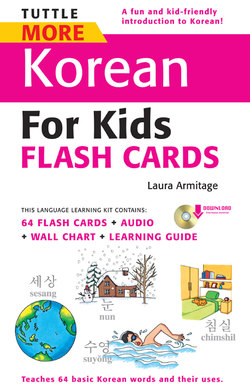Читать книгу Tuttle More Korean for Kids Flash Cards Kit Ebook - Laura Armitage - Страница 6
На сайте Литреса книга снята с продажи.
ОглавлениеHow to Use the
Tuttle MORE Korean for Kids Flash Cards
Congratulations: with this educational tool, you and your child are about to learn Korean, and you’ll have fun on the way.
These flash cards comprise 64 words and over 128 sample sentences that have been thoughtfully arranged to help you learn the basic words that are most used in Korea, and put those words together to communicate. With the simultaneous use of the audio CD and the flash cards, you and your child will find it an enjoyable adventure to learn the Korean language. Let’s begin!
A Quick Introduction to the Korean Language
The Korean writing system, known as Hangul, was invented by King Sejong in 1443 and was published in 1446. Hangul was invented to make Korean easy to read; it had only 28 letters and so could be learned by anyone in only a few days. This phonetic writing system is made up of consonants resembling the shape of the mouth and tongue as they form the corresponding sounds.
Before Hangul was invented, Chinese characters (called Hanja) had been used for writing Korean. They are still used in combination with the Korean alphabet, mainly in the newspapers, magazines, academic papers and official documents. Today, a typical South Korean high school student has to memorize 1,800 Hanja before graduating.
The invention of Hangul enabled Koreans from all classes—not only the aristocracy—to learn to read and write. The Koreans celebrate this extraordinary development with a national holiday, Hangul Day, which falls on October 9.
Using Tuttle MORE Korean for Kids Creatively
Children learn best by hearing and saying the words in meaningful contexts rather than just reading and memorizing the words. Use the audio CD, play games and sing songs as you teach/learn the words. When a child can remember the word for two weeks straight then the card has been mastered. To celebrate, you can either file it away in a special “mastered” box, or put it on a wall.
Review one category (for example, “Animals”) at a time, using the audio CD. Say the words along with the CD and then on your own. Repeat until you are familiar with the sound of the words and the proper way to pronounce them.
Children love to play games as they learn—they don’t even notice that they’re learning. Once the children know the words in a category, they are ready to play a game using the language. Making games out of common tasks is one way; try walking around and naming or labeling objects in your house or classroom using Korean words. Another creative way to practice Korean is to play some of the games we grew up with like Twenty Questions, Charades, Hangman, and even hide and go seek. Or make up your own brand-new games together. See page 9 for some other game ideas that can help make practicing Korean fun.
Other Learning Tips and Strategies
• Start with whatever topic interests your child/students. If he is excited about a recent trip to the zoo, it might be a great time to talk using the Animals cards. If she is interested in the outdoors, talking about Nature or Weather in Korean might be fun.
• Learn one word/category at a time. Learning a word together with a group of similar words can help make learning easier. Use the cards to invent modified versions of any favorite card game, as one way to practice saying the particular category of words that you’re focusing on.
• Be a model! Children learn by watching. Try to use the Korean words and phrases every day, as often as you can; if you focus on trying (instead of worrying about your pronunciation), children will do the same.
• Practice speaking with native speakers. Make an effort to find some Korean speakers near you. Perhaps at a school, community center, restaurant or church you might find some new friends who will be delighted to know that you and your child are learning their language.
• Attend and participate in Korean cultural events near your home.
How the Korean Alphabet Works
There are 24 letters in the Korean (Hangul) alphabet: 14 consonants and 10 vowels. These 24 letters are written together to form syllable blocks. A syllable block can be constructed in one of two forms: either consonant + vowel or consonant + vowel + consonant.
